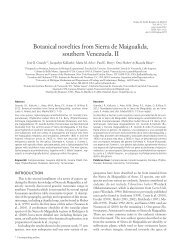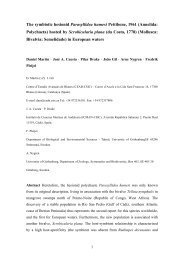FUNCTIONAL AND BIOACTIVE PROPERTIES OF COLLAGEN AND ...
FUNCTIONAL AND BIOACTIVE PROPERTIES OF COLLAGEN AND ...
FUNCTIONAL AND BIOACTIVE PROPERTIES OF COLLAGEN AND ...
Create successful ePaper yourself
Turn your PDF publications into a flip-book with our unique Google optimized e-Paper software.
1.- Introduction<br />
Gelatin is a soluble protein compound obtained by partial hydrolysis of collagen, the main fibrous<br />
protein constituent in bones, cartilages and skins; therefore, the source, age of the animal, and type of<br />
collagen, are all intrinsic factors influencing the properties of the gelatins (Johnston-Banks, 1990).<br />
Although to date, up to 27 different types of collagen have been identified, type I collagen is the most<br />
widely occurring collagen in connective tissue. Interstitial collagen molecules are composed of three<br />
α-chains intertwined in the so-called collagen triple helix. This particular structure, mainly stabilized<br />
by intra- and inter-chain hydrogen bonding, is the product of an almost continuous repeating of the<br />
Gly-X-Y- sequence, where X is mostly proline and Y is mostly hydroxiproline (Asghar &<br />
Henrickson, 1982). Only the very short N- and C-terminal regions, called telopeptides (15-26 amino<br />
acid residues), do not form triple helical structures as they are largely made up of lysine and<br />
hydroxylysine (Hyl) residues, as well as their aldehyde derivatives, in both intra- and inter-molecular<br />
covalent cross-links (Bateman, Lamandé & Ramshaw, 1996). Four to eight collagen molecules in<br />
cross-section are stabilized and reinforced by covalent bonds to constitute the basic unit of collagen<br />
fibrils. Thus, the typical strong, rigid nature of skins, tendons and bones is due to the basic structure<br />
formed by many of these cross-linked collagen fibrils.<br />
Insoluble native collagen must be pre-treated before it can be converted into a form suitable for<br />
extraction, which is normally done by heating in water at temperatures higher than 45ºC. A chemical<br />
pre-treatment will break non-covalent bonds so as to disorganize the protein structure, thus producing<br />
adequate swelling and collagen solubilization (Stainsby, 1987). Subsequent heat treatment cleaves the<br />
hydrogen and covalent bonds to destabilize the triple helix, resulting in helix-to-coil transition and<br />
conversion into soluble gelatin (Djabourov, Lechaire & Gaill, 1993; Gómez-Guillén, Turnay,<br />
Fernández-Díaz, Ulmo, Lizarbe & Montero, 2002). The degree of collagen conversion into gelatin is<br />
related to the severity of both the pre-treatment and the warm-water extraction process, as a function<br />
of pH, temperature, and extraction time (Johnston-Banks, 1990). Two types of gelatin are obtainable,<br />
depending on the pre-treatment procedure and are known commercially as type-A gelatin (isoelectric<br />
point at pH~8-9) and type-B gelatin (isoelectric point at pH~ 4-5) obtained under acid and alkaline<br />
pre-treatment conditions respectively. Industrial applications call for one or the other gelatin type,<br />
depending on the degree of collagen cross-linking in the raw material. Because of the acid lability of<br />
cross-linking in immature collagens, such as in fish skins, reasonably mild acid treatment is enough to<br />
effect collagen solubilisation (Montero, Borderías, Turnay, & Leyzarbe, 1990; Norland 1990).<br />
Gelatin quality for a particular application depends largely on its rheological properties (Stainsby,<br />
1987). Apart from basic physico-chemical properties, such as composition parameters, solubility,<br />
transparency, colour, odour and taste, the main attributes that best define the overall commercial<br />
quality of gelatin are gel strength and thermal stability (gelling and melting temperatures). For<br />
2

















